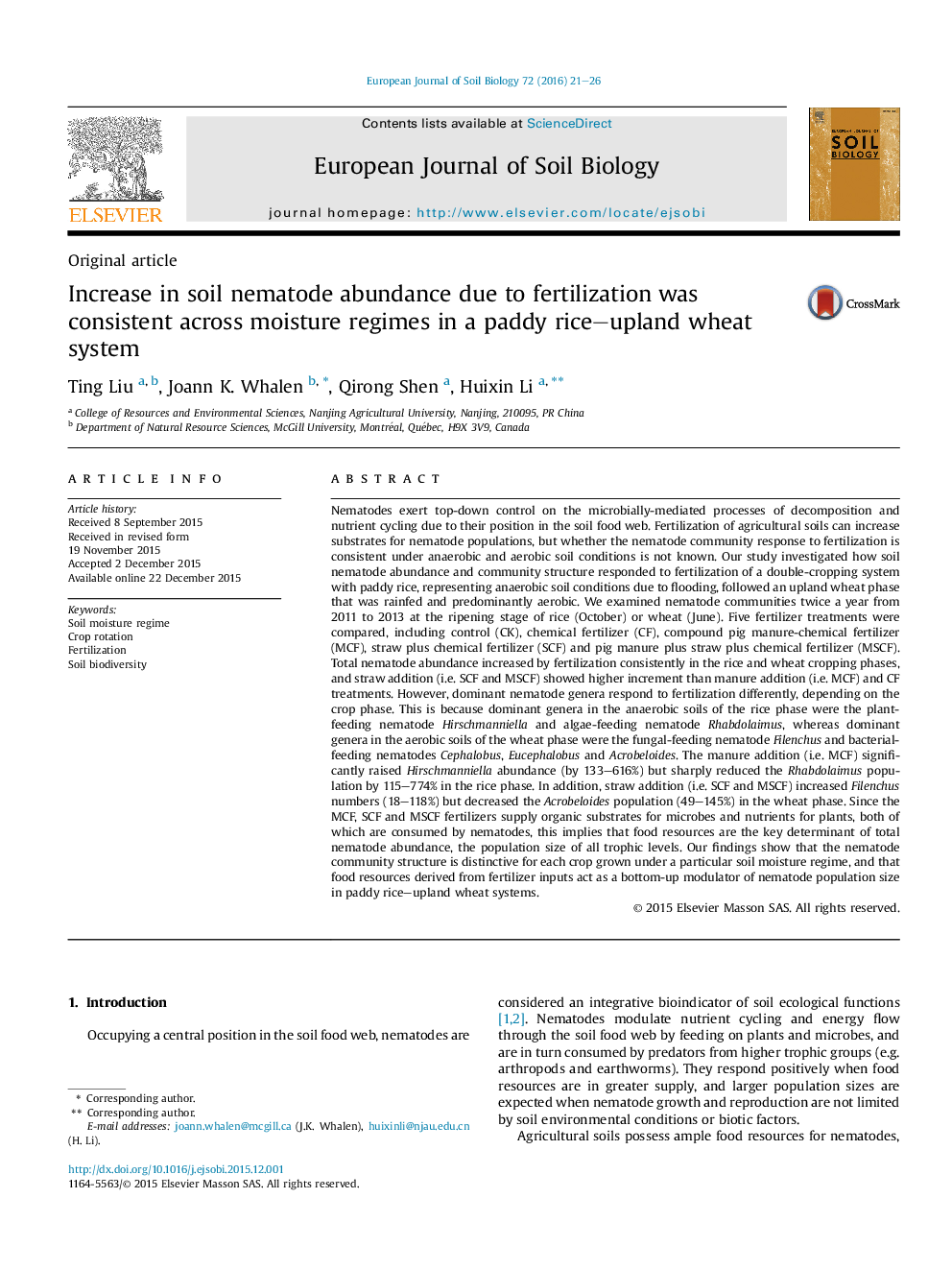| کد مقاله | کد نشریه | سال انتشار | مقاله انگلیسی | نسخه تمام متن |
|---|---|---|---|---|
| 4391657 | 1618120 | 2016 | 6 صفحه PDF | دانلود رایگان |
• Total nematode abundance increased by fertilization of rice and wheat.
• Aerobic environment supports more bacterial- and fungal-feeding nematodes.
• Anaerobic environment favors the growth of plant- and algae-feeding nematodes.
• Straw addition benefits the growth of fungal-feeding nematodes.
Nematodes exert top-down control on the microbially-mediated processes of decomposition and nutrient cycling due to their position in the soil food web. Fertilization of agricultural soils can increase substrates for nematode populations, but whether the nematode community response to fertilization is consistent under anaerobic and aerobic soil conditions is not known. Our study investigated how soil nematode abundance and community structure responded to fertilization of a double-cropping system with paddy rice, representing anaerobic soil conditions due to flooding, followed an upland wheat phase that was rainfed and predominantly aerobic. We examined nematode communities twice a year from 2011 to 2013 at the ripening stage of rice (October) or wheat (June). Five fertilizer treatments were compared, including control (CK), chemical fertilizer (CF), compound pig manure-chemical fertilizer (MCF), straw plus chemical fertilizer (SCF) and pig manure plus straw plus chemical fertilizer (MSCF). Total nematode abundance increased by fertilization consistently in the rice and wheat cropping phases, and straw addition (i.e. SCF and MSCF) showed higher increment than manure addition (i.e. MCF) and CF treatments. However, dominant nematode genera respond to fertilization differently, depending on the crop phase. This is because dominant genera in the anaerobic soils of the rice phase were the plant-feeding nematode Hirschmanniella and algae-feeding nematode Rhabdolaimus, whereas dominant genera in the aerobic soils of the wheat phase were the fungal-feeding nematode Filenchus and bacterial-feeding nematodes Cephalobus, Eucephalobus and Acrobeloides. The manure addition (i.e. MCF) significantly raised Hirschmanniella abundance (by 133–616%) but sharply reduced the Rhabdolaimus population by 115–774% in the rice phase. In addition, straw addition (i.e. SCF and MSCF) increased Filenchus numbers (18–118%) but decreased the Acrobeloides population (49–145%) in the wheat phase. Since the MCF, SCF and MSCF fertilizers supply organic substrates for microbes and nutrients for plants, both of which are consumed by nematodes, this implies that food resources are the key determinant of total nematode abundance, the population size of all trophic levels. Our findings show that the nematode community structure is distinctive for each crop grown under a particular soil moisture regime, and that food resources derived from fertilizer inputs act as a bottom-up modulator of nematode population size in paddy rice–upland wheat systems.
Journal: European Journal of Soil Biology - Volume 72, January–February 2016, Pages 21–26
